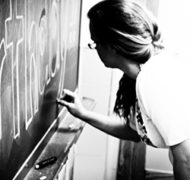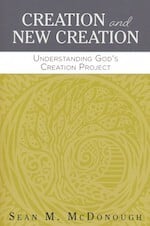Books on Culture: Life After Art, part one
Blog / Produced by The High Calling
When I was in third grade, my teacher was the one officially designated as the “art teacher” for the entire grade. My mother loved telling her relatives and neighbors that I had the art teacher. What she didn’t say was that Mrs. Sibley was in her early to mid-60s, rarely could remember our names, and told stories so outrageous that even we eight-year-olds knew she was telling something other than the truth.
But art we did. We had two big simultaneous projects. The class was divided right down the middle. The teacher had the janitor tape a long roll of brown paper, roughly three feet wide and forty feet long, to the classroom walls.
We painted murals.
My side of the classroom had “Life in Brittany” as its subject, and the other side had “Life in Norway.” They came out about how you might expect murals by a mob of third graders to come out. My mother gushed. The teacher gave us the evil eye.
No, it wasn’t stellar artwork suitable for hanging in the National Gallery. But our teacher did something else, something that lasted, at least for me. In between her lying stories, she integrated the art project with the rest of the curriculum. So if we were painting a mural of Brittany, we had to read a book on Brittany and do a book report, we had a geography and map project on Brittany, we had history lessons on Brittany. And if she could have she would have had us learn our multiplication tables in Breton (which likely would have been easier than Norwegian).
What we learned was that art is part of life, and that each of us, in our own way, was an artist.
As Matt Appling might point out, we have something of the image of the creator in us, and we are all born naturally creative. At some point, we have the artist “discouraged” out of us; art is nice but it’s not going to put food on the table. Or so we’re told.
And yet. Appling wrote Life After Art: What You Forgot About Life and Faith Since You Left the Art Room specifically because it’s not about art and creativity. This art and creativity “thing” is actually about “faith, family, hope, disappointment, dreams, failures, and all the other things that make up adult life.”
Appling wants to take us back to the art room, the one with the murals of Brittany and Norway.
An art teacher, he notes three characteristics of every child: All children are born artists. All children are natural risk takers. And children lack self-consciousness.
These are true until sometime in the sixth grade, then a transformation happens. Those characteristics are submerged. We become extraordinarily self-conscious, we shun risk, and we believe artists are weird, or at least not cool. For whatever reasons, creativity stopped being important, we learned our limitations, and we got lazy, Appling says.
The fact is, creativity is not easy. It doesn’t come gushing out in some stream of consciousness tsunami that splatters paint and words and musical notes all over the landscape. Creativity takes work— hard work. And learning. And practice. And experimentation.
Creativity is anything but easy.
Today, I often feel like I’m back in the third grade (even listening to those lying stories). It’s taken a lifetime, but I find myself enjoying the art museum more than I ever did. I enjoy creating things, especially with words. I’m seeing my life as it’s meant to be seen—all of a piece, and all of a whole. My work for a business organization demands creativity, and that creativity is learned and full of design and purpose.
I want to be a third grader again. Perhaps I already am.
On Mondays in September we're discussing Life after Art: What You Forgot about Life and Faith Since You Left the Art Room by Matt Appling. If you are reading along this month, join the discussion in the comments or drop you link there if you blog your thoughts. Next week Charity Singleton Craig leads our discussion of chapter three “Life without Beauty.” I hope you'll join us.





